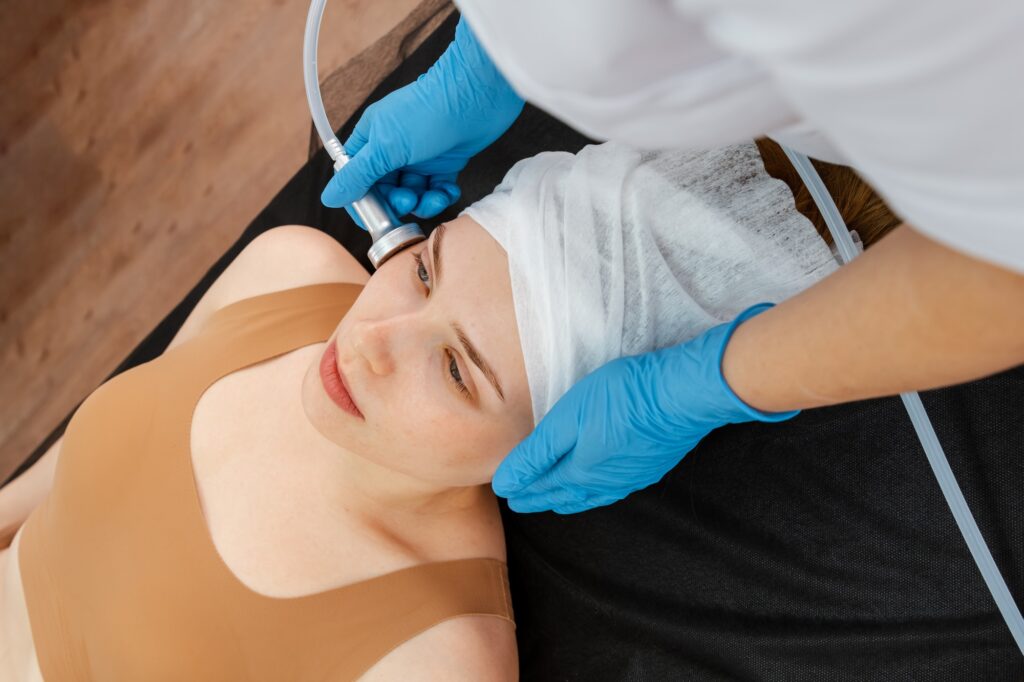Table of Contents
ToggleUltimate Guide to Fat Grafting for Facial Rejuvenation and Youthful Results
If you’re looking for a way to refresh your face that doesn’t involve synthetic fillers or implants, fat grafting can be the ideal option. It uses your body’s own fat to restore volume, sculpt your features, and improve skin health is a natural, lasting approach, and it can also enhance your complexion long after recovery. Many people report that fat grafting helps them finally see the fullness and lift they lost over time, with results that look like “younger you,” not “made over you.”
Here’s everything you need to know, from how it works to what to expect before, during, and after, so you can make an informed decision with confidence.
What Is Facial Fat Grafting and Why Is It Popular?
- Facial fat grafting takes fat from one part of your body, commonly the abdomen, thighs, or flanks, and transfers it into areas of the face that have lost volume due to aging. Because you’re using your own tissue, the result is completely natural and biocompatible.
Unlike fillers that can leave behind synthetic residue or feel stiff, fat grafting is regenerative. Fat contains mesenchymal stem cells and growth factors, which promote collagen production, boost elasticity, and improve skin texture over time. Many people consider it the ultimate “natural filler” that not only restores volume but enhances skin as well.
How the Fat Grafting Process Works?
- Facial fat grafting is a multi-step surgical process performed under local anesthesia with sedation or general anesthesia:
Harvesting
- Fat is gently removed using liposuction from donor sites like the abdomen or thighs.
Purification
- The fat is processed typically via centrifugation or filtration to separate viable fat cells from fluids and damaged tissue.
Injection
- The purified fat is carefully injected using small cannulas into target facial zones such as cheeks, temples, tear troughs, jawline, or nasolabial folds layer by layer for smooth contouring and symmetry.
This meticulous, artistic approach lets your surgeon sculpt your features with precision, using only the volume needed for natural enhancement.

Benefits of Fat Grafting for Facial Rejuvenation
Fat grafting for facial rejuvenation offers numerous advantages over traditional fillers or implants:
1. Restored Volume That Looks and Feels Natural
- As we age, areas like the cheeks, temples, under-eyes, and jawline can sink inward, leaving hollows, sagging skin, or a flat profile. Fat grafting addresses this by transferring your own fat into those areas.
Unlike fillers, the injected fat lives on, blends with your tissue, and behaves like native fat. The results don’t feel stiff or overdone; they feel soft, allow natural expression, and move with your facial muscles. Over time, the volume remains while your skin continues to soften and firm.
2. Long-Lasting Results with Longevity
- With standard dermal fillers, volume can fade in six to eighteen months and require frequent touch-ups. With facial fat grafting, about 40–60% of the fat survives long-term and remains in place once it establishes a blood supply.
Once the grafted fat integrates, it often stays for several years without needing repeated treatments. Many patients enjoy their rejuvenation for a significantly longer span, as long as they maintain a stable weight.
3. Improved Skin Quality From the Inside Out
-
With standard dermal fillers, volume can fade in six to eighteen months and require frequent touch-ups. In contrast, fat grafting for facial rejuvenation offers longer-lasting results—about 40–60% of the transferred fat survives long-term and remains in place once it establishes a blood supply.
Over the months following your procedure, as grafted fat regenerates, you may notice your skin looking clearer, smoother, and more luminous without extra treatments.
4. Natural Contouring & Facial Harmony
- Fat grafting for facial rejuvenation isn’t a one-size-fits-all procedure. A skilled surgeon carefully places small amounts of purified fat in specific layers to subtly reshape contours—lifting the cheeks here, defining the jawline there, and filling under-eye hollows just enough to smooth transitions and restore youthful harmony.
The result isn’t dramatic; it’s a refined balance. You wake up looking fresher, your features appear more sculpted, and everything feels proportionate, especially when combined with other procedures like laser resurfacing or eyelid surgery.
5. Dual Benefit: Body Contouring & Facial Enhancement
- If you have excess fat in areas such as your abdomen, hips, or thighs, fat grafting gives you two wins in one. Liposuction harvests fat from those areas, providing some light slimming as you prepare it for facial transfer.
So while your face gains youthful volume, your body benefits from subtle sculpting at the donor site. It’s a natural way to tighten and balance two areas at once.
6. Lower Risk of Reaction or Allergies
- Because you’re using your tissue, there’s no risk of allergic reaction or rejection, an issue occasionally seen with synthetic fillers. The material is completely biocompatible. As long as the grafting procedure is performed by an experienced, board-certified surgeon using sterile technique, potential complications are minimal. This enhances both safety and comfort during recovery.
Each of these benefits combines to create a comprehensive, natural approach to facial rejuvenation.

Who Is an Ideal Candidate?
- Fat grafting is best suited for people who:
- Are in good health and non-smokers. Smoking impairs circulation and graft survival.
- Have adequate donor fat available. Even lean individuals usually have enough fat for facial transfer.
- Want subtle, natural enhancement, not dramatic filler volume.
- Are willing to maintain a stable weight after surgery.
This procedure is not recommended for those with severe skin laxity who need a facelift or surgical tightening instead.
What to Expect Before, During, and After
Before the Procedure
- In your consultation, your surgeon will evaluate your facial concerns, like volume loss in specific zones, and review your health history. You’ll receive instructions to stop smoking at least six weeks beforehand and optimize your nutrition to support healing and fat survival.
Surgical Appointment
- Treatment typically takes 2–3 hours, depending on the number of areas treated. You’ll go home the same day with post-op instructions and support.
Recovery Timeline
Days 1–7
- Expect moderate swelling and bruising at harvest and injection sites. Ice and elevation help reduce swelling. Avoid massage or pressure on treated areas to preserve graft integrity.
Days 8–15
- Swelling begins to subside. Makeup can often mask residual bruising if needed. Most people return to work by the end of week two or three.
Weeks 3–4
- Fat begins to stabilize, and surplus volume gently diminishes.
Months 1–3
- Ongoing gentle skin improvement thanks to collagen stimulation.
Months 3–6 and beyond
- Final volume sets in as surviving fat integrates fully. By month nine, final results emerge: balanced volume, smooth facial lines, and rejuvenated tone.
Many surgeons recommend waiting 6–12 months before any touch-up because inflammatory changes need time to settle.
Potential Risks and Complications
- Fat grafting for facial rejuvenation is generally considered safe with low complication rates, but it’s still surgery, and risks exist. Common issues include uneven graft survival, temporary asymmetry, minor nodules, prolonged swelling, or infection. Rare but serious complications include fat embolism or, in very rare cases, vision issues if injected near vascular structures.
Choosing an experienced, board-certified plastic surgeon like Dr. Stanwix significantly reduces these risks through careful technique and personalized planning.
Monitoring and Follow-Up
- Your surgeon will schedule follow-up visits to check graft uptake, monitor for complications, and ensure healthy healing. Stay in communication if asymmetry persists or any unusual changes appear.
Final Thoughts: Why Fat Grafting Stands Out
- With face fillers, you get temporary volume and potential long-term maintenance needs. With fat grafting, you get natural volume that lingers and enhances your skin from within. It’s no surprise that demand is rising among patients seeking a lower-maintenance, longer-lasting, and entirely biocompatible approach to facial rejuvenation.
FAQs: What Patients Ask Most

How long until I see the final results?
Initial fullness appears right after surgery, but as swelling subsides and the body resorbs some fat, the true result becomes visible by 3 to 6 months, and final volume often emerges by month 9.
Will I need more than one session?
It’s common to require a second procedure in about 6–12 months to fine-tune fullness or compensate for resorption.
Is recovery painful?
Most find discomfort manageable with over‑the‑counter pain relievers and mild soreness in donor areas. Facial swelling and bruising typically resolve in two weeks.
Can this be combined with other treatments?
Yes, fat grafting for facial rejuvenation pairs well with facelifts, eyelid surgery, laser resurfacing, or cheek sculpting to create a more comprehensive and harmonious rejuvenation plan.
Are the results permanent?
Yes, once fat cells establish a blood supply, they behave like native tissue. But weight changes or aging can alter contours over time.
Why Choose Dr. Stanwix in Richmond for Fat Grafting
At Stanwix Plastic Surgery, you’re not just a procedure for Fat Grafting for Facial Rejuvenation, you’re a person seeking natural, tailored results. Dr. Matthew Stanwix combines precise surgical technique with an artistic approach to restore harmony and balance. If you’re tired of looking tired or want to reclaim a natural fullness that ages with you, scheduling a consultation is your first step toward rejuvenation.

